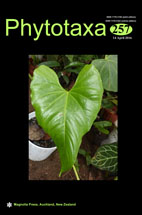Abstract
Aspidistra revoluta (Asparagaceae) is described and illustrated as a new species from limestone areas in southern Chongqing Municipality, China. The new species can be distinguished from the other Aspidistra species by its unique umbrella-like pistil with large revolute stigma lobes that bent downwards and touch the base of the perigone. A detailed morphological comparison among A. revoluta, A. nanchuanensis and A. carnosa is provided. The pollen grains of A. revoluta are subspherical and inaperturate, with verrucous exine. The chromosome number is 2n = 38, and the karyotype is formulated as 2n = 22m + 6sm + 10st. The average length of chromosome complement is 4.50 μm, and the karyotype asymmetry indexes A1 and A2 are respectively 0.37±0.03 and 0.49±0.01.

